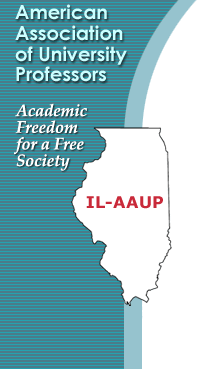Home | IL Academe | About IL AAUP | Conference Corner | Calendar | Services | Committees | Contact Us | Grants | Reports | Links
 |
 |
 |
Patriotic Correctness: Academic Freedom and Its Enemies Patriotic Correctness: Academic Freedom and Its Enemies by John K. Wilson (Paradigm Publishers, 2008) Reviewed by Lee Maltby It is probably very easy for people who are not involved in higher education to dismiss the concerns of faculty today. Aside from all the myths about how faculty possess a job that is overpaid, requires little work, has lots of vacation, and is very safe from being terminated even when the economy is lousy, now we should care because their academic freedom is threatened? Lend me a handkerchief, will you? But the average citizen (and especially uninvolved/uninformed faculty) should be concerned, because what John Wilson succinctly and unceasingly presents, is a system of education that is under assault and its deterioration has consequences for our country and the world. The main idea of the book is simple: Support faculty and thereby encourage the exchange of ideas. What the text presents is a variety of tactics (mostly by conservative organizations) to do just the opposite, including plain old deceit, twisting words and concepts to confuse arguments, financial threats, political interference (by politicians and board members), a double standard disguised as fairness (esp. in matters related to religious bodies), and corporate methods such as influencing research or withdrawing financial support, in order to intimidate, silence, and oppress people who possess “liberal” ideas and positions. The book describes the many ways whereby the “right” seeks to subvert the “left,” and to be fair, Mr. Wilson includes examples of where liberals have tried to silence conservatives, but the book is clear: the majority of attempts have been made to silence the “left”—to neutralize dissent, or what some call anti-government “unpatriotic” speech, and anti-religious or “immoral” thought. The book is thorough and detailed: the number of references approaches an astonishing degree. The organization of the chapters is well-done, and Mr. Wilson exhibits a degree of humor and balance that is a pleasure to read (especially for those of us who thought we knew him, if only a little!). After seven chapters of reporting on the many ways and arenas where academic freedom is threatened (for both faculty and students), the eighth chapter, the “Wal-Mart University,” is the capstone and likely predictor of higher education in the United States—and it is depressing reading. The intrusion of the corporate profit mentality is clearly undermining faculty and higher education. The MBA model for education that stresses consumer satisfaction, efficiency, accountability, and assessment, is having dire consequences for students and faculty. For example, even as the quality of education suffers, there is little public support nor political will for reversing the trends of recent years. One result is that the incentives for earning an advanced degree and seeking a full-time position in higher education are disappearing. Yet, the need for (and disappearance of) full-time tenured faculty can be linked to the growing numbers of college graduates who are poorly equipped for life after college. The book is valuable for its call to promote debate and open discussion. Today the buzzword in many circles is ‘transparency.’ There is now a website, www.transparency.com, that evaluates the transparency of how nations and corporations conduct their business in the modern world. If more ideas (of governments, businesses, universities, etc.) were open and subject to debate, perhaps the public and our political leaders could make intelligent proposals to remedy society’s ills. If proposals for military action were open to discussion and dissenters did not fear for their reputations and positions, then perhaps the United States would not be involved in an illegal and immoral war in Iraq. Clearly, when debate is stifled, when dissenters are silenced, then we are no longer a free society. The bottom line, as John Wilson states in the conclusion, is that “A free society requires free universities.” The only minor criticism I have of the text is that it assumes that the reader has a solid grasp of the importance of academic freedom and how tenure supports that very valuable freedom. In the Wal-Mart university there is no place for academic freedom. Just do your job! In the politicized government/corporate financed system of education and research, where dissenters are silenced and truth can be buried, the loss of tenure and the lack of academic freedom is costly and harmful. One need only look at how the EPA has been twisted to undermine the science that demonstrates that climate change is real; we ignore that science at our own peril. Academic freedom and tenure are central to our well-being and our freedom, yet the number of faculty who are full-time and tenured continues to decline. Mr. Wilson concludes the text with a number of suggestions on how to foster debate and support academic freedom. He is correct when he says that liberals and conservatives need one another, for it is through intelligent debate that we become educated. The United States needs a debate about the role of higher education and academic freedom in a post 9/11 world. And faculty need to find ways to become involved in this debate, as their freedom and that of the public is at risk.
|
|